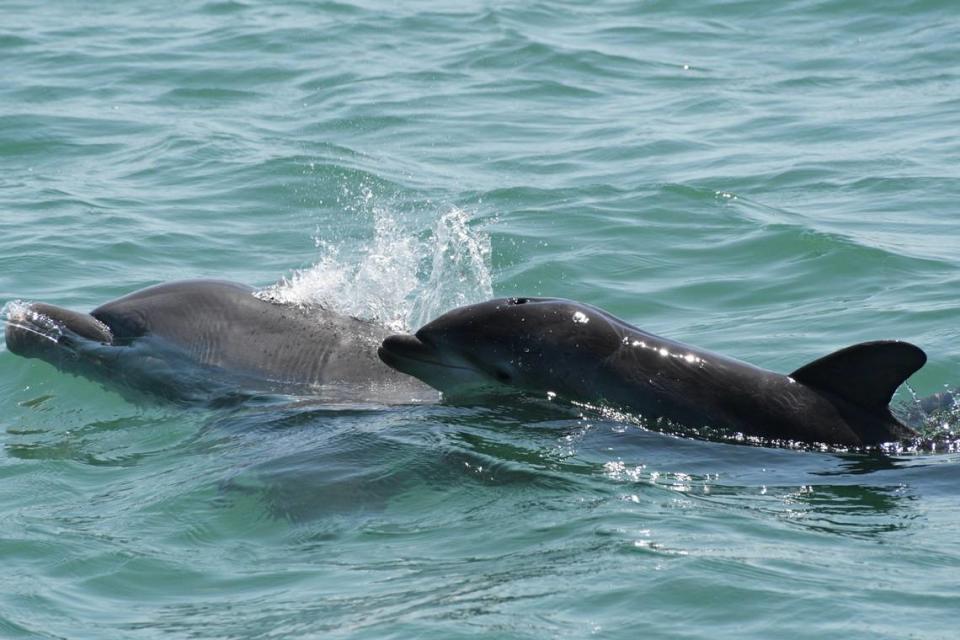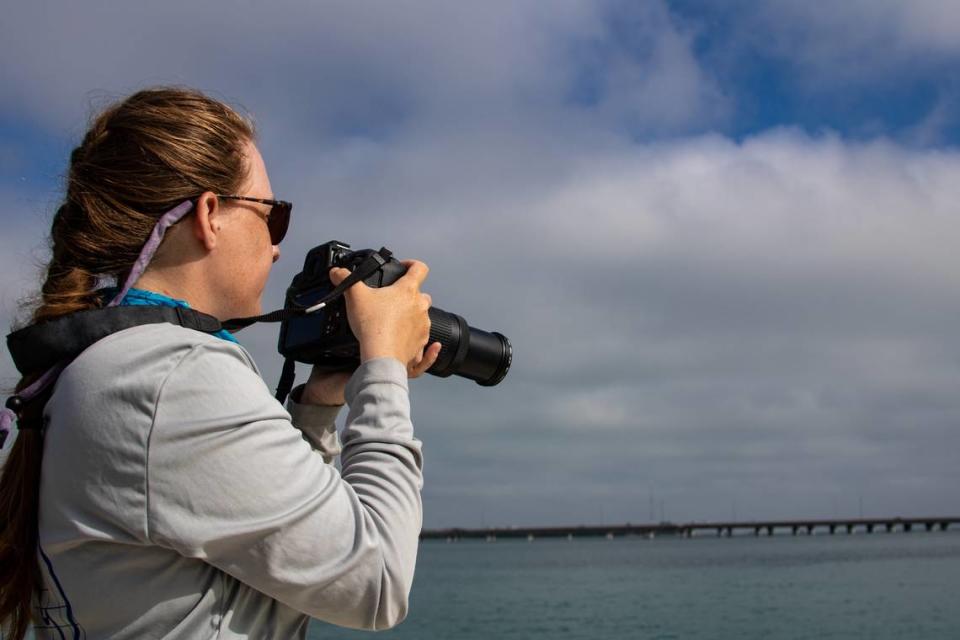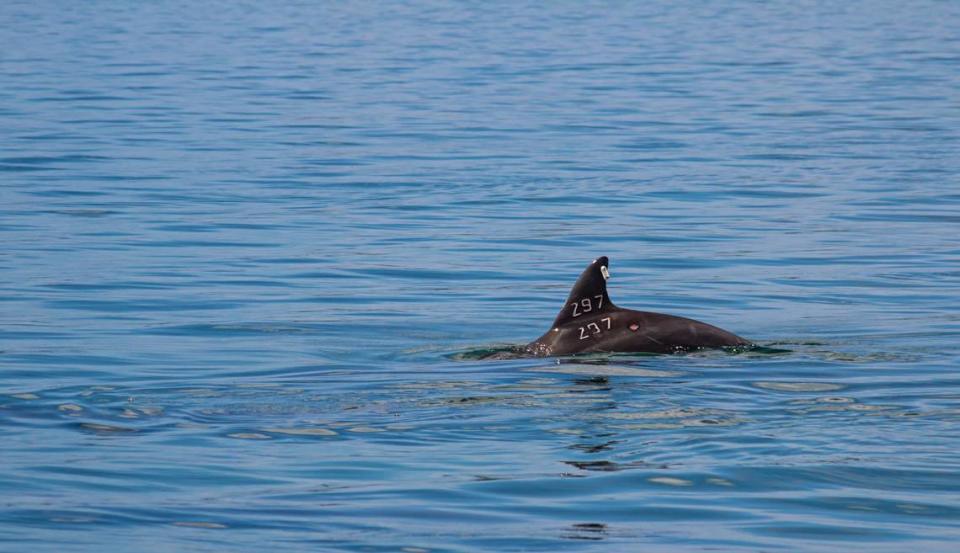Sarasota dolphin researchers dig deep to find family ties. ‘Not just anonymous gray bodies’
Sarasota Bay regularly attracts its share of visitors in the form of weekend boaters, fishing enthusiasts and sightseers.
But it’s also a multigenerational sanctuary for bottlenose dolphins, many of which exhibit human-like tendencies that form the basis of scientific study by the Sarasota Dolphin Research Program, the longest continuously running examination of a dolphin population in the United States.
More than just animals to fleetingly admire from a causeway or pleasure boat, dolphins have gotten to know the researchers (and vice versa) over the decades. Together, they are each learning what makes the other tick.
“They’re not just anonymous gray bodies out there,’’ said Dr. Randall Wells, who founded the project in 1989 and serves as the senior scientist and project manager.
“They are individuals who have been here far longer than most of the people have been, who have a social structure that is complex, a communication structure. They breathe the same air, they swim in the same water, eat the same fish as we do.”
Maddie, known scientifically as F213, is a 16-year-old female identifiable by her distinctly rigid and torn dorsal fin. She is part of “a lifelong and well-known female lineage in Sarasota Bay,” and is regularly observed on photo surveys by the team, which they do periodically aboard boats in the bay.
The species typically live 30 to 50 years.

SDRP operates from Mote Marine Laboratory and is managed by the Chicago Zoological Society. Researchers estimate there are roughly 170 year-round dolphin residents of Sarasota Bay.
Maddie is known to regularly frequent an area near New College of Florida, where the team can count on seeing her with relative consistency.
Listening through a passive listening station under the water, researchers have learned to recognize her voice as well as her appearance, keeping tabs on her even when they’re not on the water.
F165 is a 24-year-old female dolphin identifiable by two notches high on her dorsal fin. She is the one of the longest running subjects of the SDRP’s research, first observed in 1999 with her mother, FB75. She recently gave birth to the first calf of 2023, her fourth.
“You learn their patterns, you learn the kinds of dramas they’ve gone through in their lives, what kind of threats they face, how they get through those situations, what’s happened with their calves over times, and so you get a good sense of what they need in order to be able to survive and thrive,” Wells said.
It’s that sense of underwater ancestry that keeps researcher Kylee DiMaggio, coming back.
“I love being on the water,’’ DiMaggio said. “I love tracking our new births. All that good stuff. A lot of the research that I’m interested in has to do with calving. So when I see new baby, I get really excited.

Though the research team does not engage or positively reinforce their presence in the interests of research integrity, they have also observed behaviors that indicate a passively friendly relationship between the researchers and the dolphins.
“We’re trying to study the animals as they’re making their living, so we observe them on a monthly basis and from a distance, (using) an approach that allows us to stay nearby to collect the data we need,” Wells said. “Sometimes they’ll come over and check us out, they sometimes will leave their calf with us while they go off and have coffee, or whatever the moms do… So we believe there is a certain level of recognition, that they can distinguish between vessels based on the sounds they make.”
The number one threat to dolphins that the team observes daily is debris left behind by recreational fishing. Dolphins are food-motivated and intelligent, so they will replicate behaviors that result in them receiving a fish — even if it is dangerous to their safety.
The team has recorded about 1,600 interactions with dolphins and has seen about a 2% increase in dolphin population. Researchers say updates to how runoff and sewage water is treated, in effect since the 1990s, have been beneficial to the ecosystem in general, with more to come as Sarasota County pursues new and different strategies to further improve bay waters with more advanced treatment methods and upland efforts to control runoff.
“About a quarter of identifiable deaths in the area are from human sources, and 19% to 20% of that is fishing gear,” Wells said, adding anglers can make a big difference by avoiding braided fishing line that can cut into dolphins’ flesh and by using fish hooks that corrode over time in salt water.

F165’s mother died in 2006 as a result of ingesting a fishing lure.
“I’m not advocating not fishing, just be careful about when fishing is occurring and under what circumstances, making sure the other creatures of the bay are staying safe while you’re enjoying the bay as well,” Wells said.
It’s that sense of Sarasota Bay as a community, which attracts newcomers and retains longtime residents, that makes the region special . . . for a variety of reasons.
“There are just very few places in the world where you can track animals for five or six generations because a lot of the marine mammal populations are migratory,’’ DiMaggio said. “So being able to know who the dolphins are (and) track their lives is really unique to Sarasota.
Sarasota Dolphin Research Program
Growing up in landlocked Illinois, marine biology and oceanography may not have been Dr. Randall Wells’ first career choice, but with an annual family vacation to Florida each year, young Wells quickly developed an affinity for marine studies.
“In the middle of high school, my family was able to move to Sarasota… not far from where I live now. I went to Riverview High School for my junior and senior years. I was able to take classes in marine biology and oceanography and get to know the Mote Marine Laboratory,” Wells said.
Through a professional connection his father had, Wells secured a summer internship with Dr. Blair Irvine, who helped Wells found the Sarasota Dolphin Research Program. Dr. Irvine, though retired, continues to manage the website and serve as President of the non-profit, Dolphin Biology Research Institute.
The SDRP provides an opportunity to scientists to study marine mammal interactions in a natural laboratory setting that, for many of these specific animals, only exists in Sarasota Bay.
“We’re getting to learn a lot about how the human population in Sarasota influences animals, and we are really able to be stewards for marine mammals in general because there are very few places that have the knowledge that we have here in Sarasota,” said research assistant Kylee DiMaggio.
In the 50 years since the SDRP began, it has evolved from its modest early beginnings to a complex research, conservation and education program.
The program has employed 480 interns, hosted more than 200 international colleagues and students that have attempted to replicate the natural laboratory concept in their own ecosystems, mentored 98 graduate students that have performed their capstone research in partnership, and welcomed more than 1,000 citizen scientists visiting to learn about dolphin conservation.
“It’s great for us to know how the animals act in the wild so that we can make suggestions for how they are managed in care facilities to make sure that animals (there) have the best and most natural life possible,” said DiMaggio.

